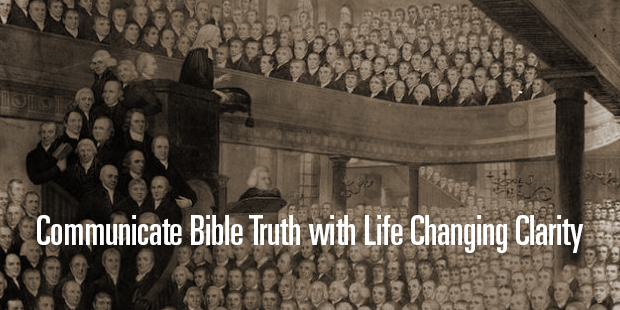“Scrambling to keep up and looking for ways to get their message heard, churches are creating more videos, designing more logos, printing more inserts, sending more emails, launching new apps and websites, posting more social media updates, and trying to write lots of captivating content.”
“Here’s what happens. The people they are trying to reach move further away just to survive the onslaught.”
The above paragraphs resonate from the introductory pages of Kem Meyer’s book “Less Chaos. Less Noise.” These words become a powerful reminder that today’s church faces a culture in which the difficulty of connecting with people has become an ever-changing proposition.
Every day, your church stewards thousands of moments of truth. Every time a member talks to a neighbor, someone drives by the church facility, a ministry e-mail goes out, a pastor’s business card is left on a desk, some interaction on behalf of the church has transpired. Every time these events happen, the church’s vision glows brighter or dims in the tiniest little increments.
The visionary leader cares too much about the message to let it just blow in the wind, unattended. Church leaders must be bold and relevant as they integrate vision into the all aspects of church communication. This can happen only with a tremendous amount of intentionality in the complex discipline of church communications.
THE QUICK SUMMARY – Building a StoryBrand by Donald Miller
Donald Miller’s StoryBrand process is a proven solution to the struggle business leaders face when talking about their businesses. This revolutionary method for connecting with customers provides readers with the ultimate competitive advantage, revealing the secret for helping their customers understand the compelling benefits of using their products, ideas, or services.
Building a StoryBrand does this by teaching readers the seven universal story points all humans respond to; the real reason customers make purchases; how to simplify a brand message so people understand it; and how to create the most effective messaging for websites, brochures, and social media.
Whether you are the marketing director of a multibillion dollar company, the owner of a small business, a politician running for office, or the lead singer of a rock band, Building a StoryBrand will forever transform the way you talk about who you are, what you do, and the unique value you bring to your customers.
A SIMPLE SOLUTION
What is clarity really about? A synthesis of definitions brings clarity to the concept of clarity: it means being free from anything that obscures, blocks, pollutes, or darkens.
Being clear as a leader means being simple, understandable, and exact.
The leader helps others see and understand reality better. Leaders constantly bring the most important things to light: current reality and future possibility, what God says about it, and what we need to do about it.
Unfortunately, there is often a gap between the leader’s words and how followers receive the leader’s words. Like a dropped cell call, this is caused by various sources of disconnection and static between people, even if the leader is communicating clearly.
Like the bars that indicate signal strength on a cell phone, every leader has signal strength levels that distinguish perceiving, thinking, and communicating with others.
The effective leader must spend extra time bridging the gaps by practicing clarity with words.
Words sell things. And if we haven’t clarified our message, our customers won’t listen.
Nobody will listen to you if your message isn’t clear, no matter how expensive your marketing material may be.
Your customers have questions burning inside them, and if we aren’t answering those questions, they’ll move on to another brand. If we haven’t identified what our customer wants, what problem we are helping them solve, and what life will look like after they engage our products and services, we can forget about thriving.
What we think we are saying to our customers and what our customers actually hear are two different things. And customers make buying decisions not based on what we say but on what they hear.
We need a filter to minimize the noise. The essence of branding is to create simple, relevant messages we can repeat over and over so that we “brand” ourselves into the public consciousness.
Donald Miller, Building a StoryBrand
A NEXT STEP
Stories move us. The engage us. They inspire us. Stories give us examples of how to act – and how not to act. The best ones stay with us forever.
To clarify your message using stories, it will be helpful to follow the formula that author Donald Miller uses in his book Building a StoryBrand. Purchasers of the book will receive free access to an online tool, the StoryBrand BrandScript.
While you will not be able to use the powerful techniques in this brief overview, you can at least get an idea of how those techniques might be used in your setting.
Here is an overview:
Nearly every story you see or hear can be outlined as: A CHARACTER who wants something encounters a PROBLEM before they can get it. At the peak of their despair, a GUIDE steps into their lives, gives them a PLAN, and CALLS THEM TO ACTION. That action helps them avoid FAILURE and ends in SUCCESS.
In a team discussion, write the key words from the above statement down the left side of a chart tablet.
- Character
- Problem
- Guide
- Plan
- Calls them to action
- Failure
- Success
Brainstorm the successful transformation you’re helping the average church member achieve by writing out ideas for each of the categories listed.
Discuss among your team how you can use the StoryBrand principles to clarify your church’s message through the telling of stories.
Every human being is already speaking the language of story, so when you begin using a story framework, you’ll finally be speaking their language.
Excerpt taken from SUMS Remix 81-1, issued December 2017.
This is part of a weekly series posting excerpts from one of the most innovative content sources in the church world: SUMS Remix book excerpts for church leaders.
SUMS Remix takes a practical problem in the church and looks at it with three solutions; each solution is taken from a different book. Additionally, a practical action step is included with each solution.
As a church leader you get to scan relevant books based on practical tools and solutions to real ministry problems, not just by the cover of the book. Each post will have the edition number which shows the year and what number it is in the overall sequence. (SUMS Remix provides 26 issues per year, delivered every other week to your inbox).
> > Subscribe to SUMS Remix <<

Tags: Building a StoryBrand, Clarify, Clarity, Donald Miller, SUMS Remix, message
|
What is MyVisionRoom? > | Back to Communication >

 On Thursday, March 19, 2020, the Auxano team will launch the Better Future Web Series. As of today (no explanation necessary on that disclaimer LOL), we are planning to bring 20-25 minutes of helpful, practical content and conversation for church teams every weekday morning at 11:00 a.m. EDT/10:00 a.m. CDT.
On Thursday, March 19, 2020, the Auxano team will launch the Better Future Web Series. As of today (no explanation necessary on that disclaimer LOL), we are planning to bring 20-25 minutes of helpful, practical content and conversation for church teams every weekday morning at 11:00 a.m. EDT/10:00 a.m. CDT. 






























